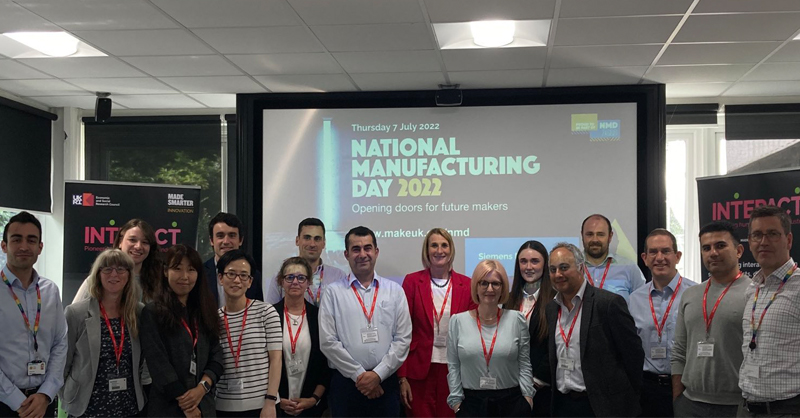A host of publications in the grey and academic literatures herald the emergence of smart manufacturing and the digital transformations brought on by new waves of technological innovation. In manufacturing the Fourth Industrial Revolution (or 4IR) is the overarching socio-technical term, sometimes used to describe the changes arising from these emerging digital technologies and practices.
Smart manufacturing combines the automation of tasks, the digitisation of processes and co-ordinating platforms of digital networks alongside technologies like artificial intelligence (AI). Like the previous three Industrial Revolutions that used steam to mechanise production, electricity to power mass production, and electronic advances in information technology to automate production, smart manufacturing represents a systematic step change. This is because of the scale and complexity of integrating various advanced digital technologies (ADTs) and digitised data in manufacturing production and distribution systems.
Some of the most cited technologies include the Internet of Things (IoT), cyber-physical systems, big data analytics, cloud (and quantum) computing, additive manufacturing, 3-D printing, advanced robotics, augmented reality and blockchain technology: a landscape that is emerging and evolving through innovation, synergy and combination.
For manufacturers there are strong digitalisation incentives: longer product lifecycles, increased operational visibility, reduced costs, optimised production cycles and direct relationships with consumers. Digital servitization is the process of providing bundles of products, services and tools (e.g. big data) for greater customer value. Fuelled by cloud computing, IoT allows the multiple interconnections of (unique) ADTs, while sensors and rendering devices provide a digital intelligence to generate real-time data and actions. These along with big data analytics and platforming enable a shift to Business-to-Customer (B2C) models: greater market reach, faster product to market cycles, more brand control, opportunities to give added-value digital intelligence to products and the collection of customer usage data to inform design and product improvements interfaced with e-commerce platforming.
Digitalisation is depicted as an (yet) uncharted blue-sky horizon of technological development whose haze blurs the lines between the physical, digital and biological worlds: a fusion of technologies that will shape manufacturing sectors, workforces, jobs (their content, design, regulation and protection) and business models in the coming years. For manufacturers, the future script is one of opportunity and uncertainty: continuing and rapid product innovation as companies vie to integrate and develop their digital toy boxes of tools, products and markets.
Smart manufacturers will have to blend ADTs with the digital skills and unique attributes of people to lever their productivity gains. Typical of publications in the grey literatures, Deloitte offer an idealised vision of the types of high-skill, high-tech white-collar graduate-level jobs and roles that smart manufacturing will generate in the very near future. These stand in stark contrast to the often-stereotypical images of older, dirty, risky, and repetitive blue-collar factory jobs that can sometimes haunt images of the sector.
Deloitte outline six prototype jobs and three of these are described as examples: the Digital Twin Engineer who can ‘virtually’ look inside physical assets, systems and structures to optimise design, performance, predict maintenance and improve customer experience; the Robot Teaming Co-ordinator who trains people and bots to work collaboratively; and a popular example often cited in the literature, the Smart Factory Manager, with responsibilities for production, quality control, inventory, connectivity and analytics. Common to all these roles is the use of sophisticated co-ordinated ADT systems, AI and the support of co-bot teams working alongside people at different levels of production and distribution.
Against the backdrop of this digital toolbox meze there is no shortage of some very familiar challenges for work and employment. Automation is strongly associated with job polarisation and the decline in the share of mid-pay mid-skill jobs observed throughout leading western economies in recent decades. Digital production processes and platforming are usually negatively linked (especially in the retail and hospitality sectors) with job (and role) fragmentation and an increase in (the sometimes precarious) work that differs from the standard relationship of permanent, full-time and secure employment (i.e. ‘gig economies’).
Some of these issues may seem very distant from Deloitte’s clean, slick and precise white-collar smart manufacturing settings outlined above, in job design, smart manufacturers will still have to be savvy enough to address the issue of how to attract talent and create meaningful work: higher pay, access to employee benefits and work that is interesting. There are still several broad workforce challenges to be faced: work architecture, workforce skills and (re)training (attracting and retaining digital talent), and what this means for human resources, organisational and job/task design (and processes), strategic organisational leadership, capabilities and cultures. Working in smart manufacturing will also have the potential to raise concerns about greater data-driven employee monitoring and exposure to physical and psychosocial risks arising from constant connectivity and the overlap of work and non-work time.
A strong theme in the literature are the demands for high-skill smart manufacturing workforces with digital and ‘soft’ skills. A recent World Economic Forum study highlighted that the top 10 skills for the next decade include what we think of as essential human skills – critical thinking, creativity and people management – alongside technical digital skills. ‘Essential’ human skills are the things that cannot be automated (yet).
This skill shift puts the emphasis on retraining existing manufacturing workforces, building ‘soft’ skilled workforce capacities and more widely, being able to attract and retain ‘digital people’ talent. To support the latter, there may be markedly better opportunities created in high-tech smart manufacturing settings for equality, diversity and inclusion initiatives around working time flexibility and the labour market integration of specific groups, such as women and those with more domestic care responsibilities and health issues. Also, as products, services, workforces and supply chains become increasingly connected, this results in new chains of value creation increasing the potential for more employee-led innovations, and distributed leadership to create more opportunities for change and building capacities for improvements to products and customer services.
A major workforce challenge in transitions to smart manufacturing will be fears about job substitution and the destruction of jobs (automageddon) by the rise of the bots (and their new co-bot allies). Automation has always been the harbinger of apprehension about its consequences for jobs and aggregate levels of employment: the jobs that people can do, the tasks they will perform and the new key skills that workers will have to acquire. This is a popular image of automation even though technology also creates many new jobs.
Historically, labour markets have always accommodated and absorbed automation. Technology complements workers skills and increases their task performance, while eliminating those manual and repetitive tasks that are easier to automate. Although technology has historically had little adverse impact on aggregate employment, this still masks some underlying processes of job destruction and creation in particular sectors and groups of workers. Initially, automation complemented low-skill work. Later, it substituted for it while complementing middle and high-skill work. Today it complements high-skill work but often substitutes for middle-skill work. It is reasonable to expect that these technology-related effects in smart manufacturing will rhythmically evolve, emerge and once again change in the future.
A significant limitation of current debates in automation and smart manufacturing is that it is very difficult to predict future levels of employment given the relative recency and quality of existing studies that are trying to map events that are still emerging in ‘real time’. There is still a great deal of speculation and uncertainty about what will happen as smart manufacturing sectors emerge, grow and develop. The Babbage Repot makes it clear that smart manufacturing is largely concentrated in larger sized companies in ten developed economies who tend to be those who make the greater share of new technology patents, investments, adoptions and implementations.
Equally important but relatively understudied, are questions about how smart manufacturers influence the design of work and jobs, and which tasks/skills can be substituted, complemented or augmented. The mechanisms by which smart manufacturing technology complements/ arguments jobs and tasks are not well understood, nor the strategic decisions that companies’ make around technology investments. In this sense, there are interesting issues about workforce engagement and dialogue: and how smart manufacturers anticipate, plan and strategically balance decisions about technological investment alongside workforce issues.










